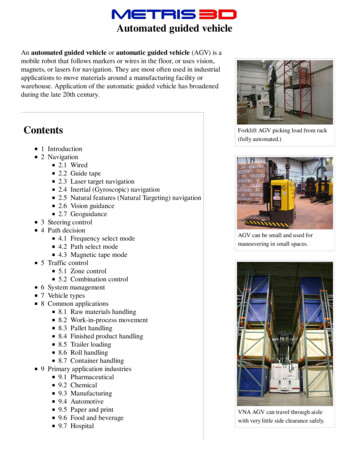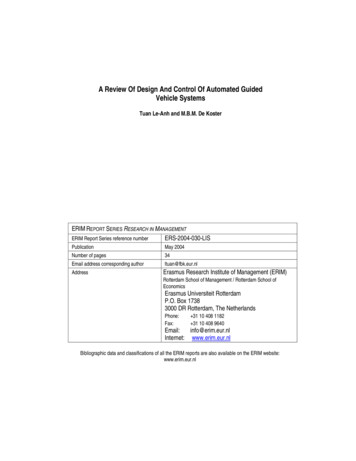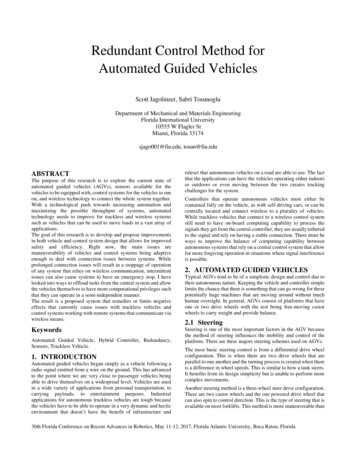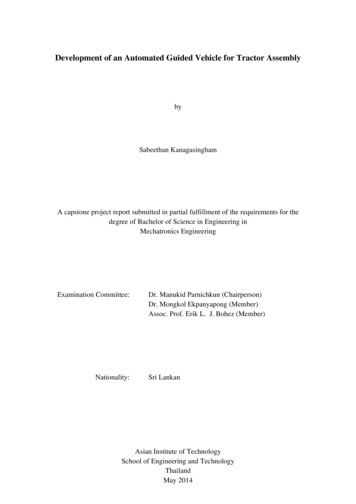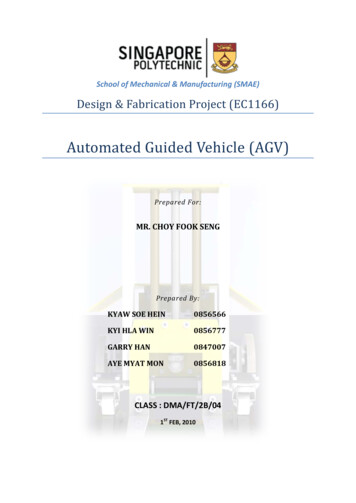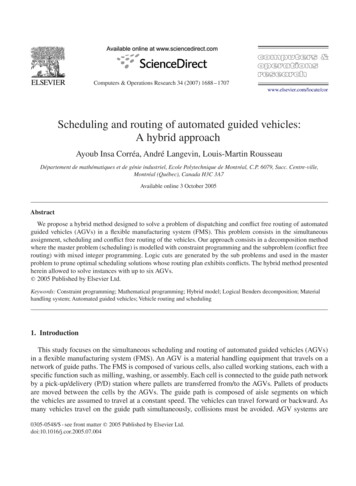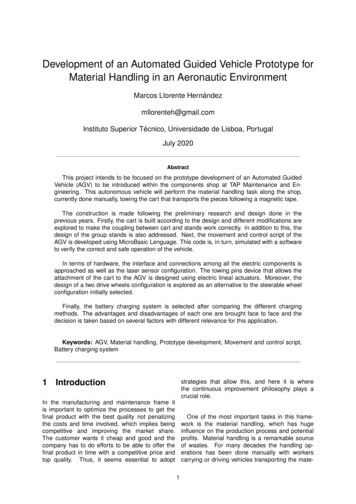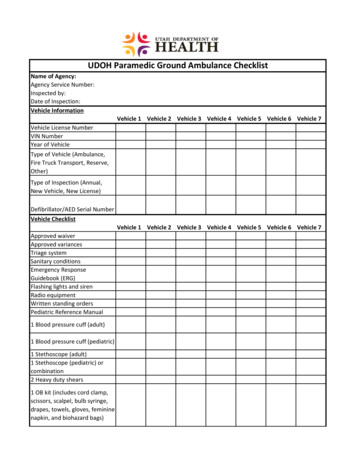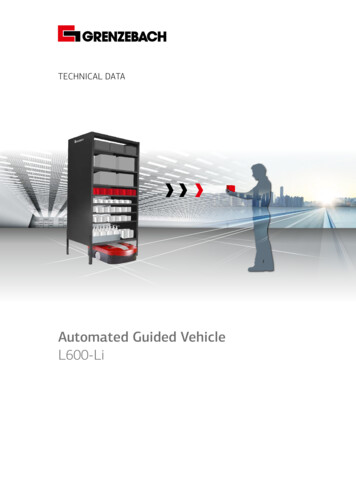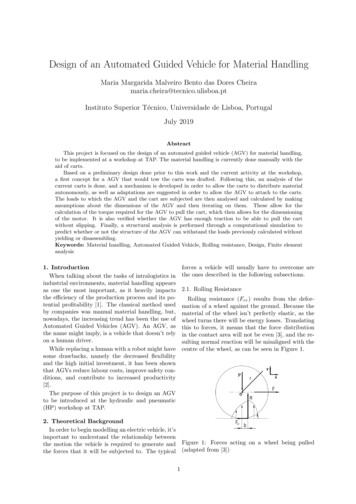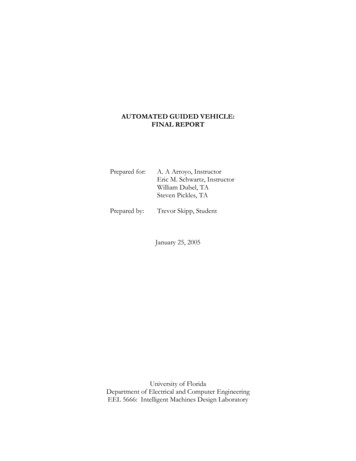
Transcription
AUTOMATED GUIDED VEHICLE:FINAL REPORTPrepared for:A. A Arroyo, InstructorEric M. Schwartz, InstructorWilliam Dubel, TASteven Pickles, TAPrepared by:Trevor Skipp, StudentJanuary 25, 2005University of FloridaDepartment of Electrical and Computer EngineeringEEL 5666: Intelligent Machines Design Laboratory
Contents1. Abstract . 32. Executive Summary 43. Introduction . 54. Integrated System 65. Mobile Platform . 76. Actuation . 87. Sensors 98. Behaviors . . 159. Experimental Layout and Results . . . 1810. Conclusion . . .1911. Documentation . 2112. Appendices . 222
Abstract“Automated Guided Vehicle”By Trevor SkippHigh demands on manufacturers have left their shipping warehouses in havoc.Human error has a negative effect on safety, efficiency, and quality. These expenses arereduced with the introduction of an Automated Guided Vehicle, AGV. A driverless,intelligent forklift uses an optical path to quickly and safely traverse a warehouse. Itscapabilities are enhanced by the ability to send and receive tasks through RF datacommunication.3
Executive SummaryIntroducing worker robots into warehouses has the potential to increase thestandards currently held by the industry. The autonomous machines have the capability ofdynamically storing pallets, lowering labor and insurance rates, and reducing the risk ofpersonal injury. To broach these goals, the Automated Guided Vehicle, AGV, was designedto collaborate with another autonomous vehicle, the Automated Storage and RetrievalSystem, ASRS.Although they appear similar, the AGV and ASRS serve two separate purposes.Catered to industries whose products can expire, the ASRS keeps track of when each palletenters the warehouse and its current location. This ensures that the oldest product getsshipped out first. The ASRS is a tall vehicle designed to navigate in the tight aisles of awarehouse floor. Although its tall mast gives it the capability of lifting pallets onto a thirdtier shelf, it restricts the vehicle travels to slow speeds to maintain a safe environment. Withall considerations in mind, the ASRS can not efficiently traverse long distances in awarehouse. The problem is easily solved with the introduction of a small, light vehicle. TheAGV can quickly travel across a warehouse while carrying a pallet. Its simple pallet jack canlift up and set down pallets at one height. Because of its small body and simple forkliftmechanism, the AGV is much less expensive than the ASRS.The AGV receives tasks from the ASRS, which can vary from picking up a pallet atthe incoming dock to delivering one a pallet to the outgoing dock. Accurate navigation isobtained by mapping high contrast lines on the warehouse floor in software.Whilenavigating and backing up, the vehicle senses its surrounding to predict an imminentcollision.4
IntroductionAdvancements in manufacturing technology allow companies to rapidly produceproducts. This has provoked a trend to reduce bulk inventory in favor of short termsupplies. Although this allows corporations more financial freedom, it requires warehousesto accommodate temporary, selective storage. Improved product handling and speed can beachieved with the implementation of an Automated Guided Vehicle, AGV.In a traditional warehouse, human safety governs the productivity. With the help ofintelligent computers, the AGV can safely achieve higher speeds. Precision turning allows itto accurately navigate in tight spaces.The AGV is highly flexible as a result of remote communication. Its ability tocommunicate with other autonomous vehicles provides a seamless operation. Continuouscoordination between vehicles delivers money saving efficiency.The introduction of unmanned vehicles onto a warehouse floor has favorable effectson safety. With the aid of environmental sensors, the AGV can detect objects in its collisionpath. Automation eliminates vehicle traffic jams and their potential for accidents.For companies building new warehouses, there are many monetary benefits toinvesting in intelligent machinery. The workforce required to run the warehouse and theadditional overhead (e.g., insurance) required to support that overhead will be drasticallyreduced. Increased product turn-around and faster shipping will result in more satisfiedcustomers. Also, automation reduces the risks of personal injury.
Integrated SystemThe AGV operated in a model warehouse, built to scale. Its primary task was torelocate pallets within the warehouse. A external input generated by an infrared remotecontrol notified the AGV whether a pallet was entering or exiting the warehouse. To get toits destination, the vehicle traversed the warehouse by following high contrast lines. Whenthe four pair line follower module detected an intersection, the AGV determined whether toturn or go straight by using an algorithm that incorporated the vehicles current location anddirection.In the first situation, the remote control signaled that a pallet was entering thewarehouse. The AGV picked up the pallet off of the incoming shipping dock and droppedit off at one of several docks at the other end of the warehouse.Through RFcommunication, the AGV told another autonomous vehicle, the ASRS, the new location ofthe pallet. The second situation allowed for a pallet to be shipped out of the warehouse.The AGV waited for the ASRS to confirm that it dropped off a pallet at one of thetransistion docks before it picked it up and moved the pallet to the outgoing shipping dock.While traveling, the AGV polled two forward facing infrared range finding sensorsto determine if an object was in its forward collision path. If and object was detected, thevehicle would stop and wait for the obstruction to be cleared. While reversing, bumpsensors detected the occurrence of a rear collision, which would permanently disable thevehicle.6
Mobile PlatformThe designer intended the AGV to be a small vehicle that could quickly traverse awarehouse and move pallets around. Creating the smallest vehicle possible required creativethinking and experimentation. A concept drawing was entered into AutoCAD 2005 andrendered in three dimensions. After the blue print was verified, a T-Tech prototypingmachine cut the platform out of eighth inch plywood.The top of the vehicle wasconstructed from thin balsa wood, which was glued to a wood skeleton that matched thecurve of the AGV. Although the fork protruded through a rectangular cutout, the lid couldstill be easily taken on and off. A second cutout was made for the infrared distance sensors,and the display lens off of a V.C.R. was modified to conceal the sensors. The platform wasprimed and painted with black and silver lacquer spray paint, and a high gloss was created byapplying polyurethane.The body was five and a half inches wide, five and a half inches long, and six inchestall. A rectangle was cut out of the back and bottom to provide for the housing of the LCDand line follower module, respectively. Arches were cut out to provide clearance for two 2.2inch diameter tires, which were mounted on the rear end of the robot, while two casterssupported the front of the robot. Three tier shelving was used to optimize space inside ofthe AGV. The center of gravity was intended to be above and forward of the motors.However, an error on the chasis design was quickly discovered once it was assembled. Athird caster was added to the extreme rear of the vehicle so the robot wouldn’t tip backwhile driving forward. The height of the new caster was precisely measured so the vehiclewould rock as little as possible.7
ActuationThe AGV required the capability to move around a model warehouse built out of asheet of plywood and to pick up pallets once it reached it’s destination. Two types ofactuation where needed to meet these objectives. Drive motors and tires added the functionof movement, while a third motor supported a pallet jack.1. Wheels and MovementThe AGV was propelled by two 200 R.P.M. D.C. gear head motors, which whereattached to the rear tires. The tires were 2.2 inches in diameter and one inch wide. With theaddition of the third caster, the majority of the vehicle’s weight rested on the rear caster, andthe tires were slipping. Thick coats of rubber cement were painted onto the tires and thevehicle regained traction.The AGV had an excellent turning radius as a result of theplatform layout. The tires resided one inch from the middle of the robot, which almostallowed it to turn in place.Forklift MechanismThe forklift was created out of wood and mounted to the platform with hinges.Serendipity struck when the hinges could not be installed perfectly straight. The hinges hadextra friction, and the fork did not flop around even though they were still moveable. Anarm was rigidly attached to the forks and mounted so that it was parallel to the forks and inthe opposite direction. A slot in the arm was created with a T-Tech prototyping machineand connected to a servo arm with a pin. When the servo was in its neutral position (zerodegrees), the forks were down and parallel to the ground. Altering the servo’s pulse widthmoved the servo arm back to negative thirty degrees and the forks up to positive thirtydegrees. Wooden stops where mounted on the fork to prevent pallets from sliding back andcrashing into the robot.8
Sensors1. Infrared DetectorThe goal of this project was to develop a robot that streamlines the warehousingprocess. An infrared remote control allowed the user to dynamically communicate with thevehicle on the factory floor. Buttons on the remote control corresponded to requests tostore or retrieve a pallet. A Sony television remote control (Sony code # 202) was used tosend infrared data. Each button on the remote had a unique bit pattern. When a button waspressed, the remote formed a packet of data including start bits, data elements, and stop bits.Digital Signal Encoding was used, and the packet was sent serially through a 40kHzmodulator. Modulating the signal decreased the probability of ambient infrared crosstalk.After modulation, the signal was sent to the infrared generator.The AGV used a Fairchild Semiconductor infrared detector to receive the signal(Figure 1). A bandpass filter was incorporated into the detector so that only 40kHz signalswere accepted. When the sensor detects infrared heat, it demodulates the signal and sets theoutput pin low. Internally, the sensor used a Schmitt trigger to reduce switching noise onthe output pin. This was highly desirable because false pulses could be mistaken as part ofthe incoming bit stream. The output was connected to the microprocessor’s low priorityexternal interrupt, which was configured to a falling edge. In the interrupt subroutine thedata was serially converted into bits by analyzing the length of the high pulses. The signalwas first analyzed on an oscilloscope.The researcher noticed that all of the pulses(excluding the start pulse) had one of two qualities. There was always a 0.25ms high or lowpulse which was fallowed by a 0.75ms high period (Figure 2.). This made it possible to haveeither a 1ms high period or a 0.75ms high period. The back end of one 0.75ms pulse plus9
the 1ms pulse provided a total pulse width of 1.75ms. This long pulse width never appearedback to back.Figure 1. IR SchematicFigure 2. Sony Code #202 Pulse WidthsIn all of the bit patterns, there were several more short pulses that long pulses. Theresearcher guessed that the data was riding on the long pulses, so he decided to call the shortpulses '0' and the long pulses '1' (Figure 3.). The bit patterns were collected for the entiresignal. A pattern was discovered upon analyzing the data. After the first five samples wereignored, the subsequent five samples where stored into an array. All other samples whereignored. The array was reversed so that first sample collected became the least significant bitin binary form. The array was converted into a hexadecimal number. With this procedure,10
button "one" on the remote gave the hexadecimal number of 1, and button "two" on theremote gives the hexadecimal number 2. This was the Sony code!Figure 3. Sony Code #202 Bit Definition2. ProximityIt was desirable for the AGV to be capable of safely traversing a warehouse withoutcolliding with obstacles in its path. Two forward facing Sharp GPD2D12 infrared rangefinders were placed approximately two inches apart. Both where pointed 30 degrees towardthe center of the robot. Obstacles were detected when something passed into the sensor’sline of sight. The sensors were preassembled and powered up with 3.3 volts. The analogoutput was connected to the microprocessor.Because the robot was operating in a model warehouse, close range sensors wherechosen to stay consistent with scale. The farthest distance the GPD2D12 can measure is 80centimeters. With a body length of 13 centimeters, the AGV is considered to be a 1:14 scale.Applying the scale, a life size AGV could detect obstacles 35 feet in front of it.3. Line FollowerNavigation will be achieved by following black lines on the warehouse floor. A fourpair line-tracking module is constructed with Optek OPB745 Reflective Object Sensors.They are constructed with infrared light emitting diodes coupled with phototransistors(Figures 4 and 5). Because the reflective properties of black and white surfaces are different,the sensor will return varying analog values relative to the surface they are above. The11
microprocessor polls these analog values and converts them to digital data: black is 23016 andwhite is 13516.Two sensors are offset one half of a centimeter from the center of the module. Thisallows the robot to center itself on a two centimeter wide strip of electrical tape. Both of theother sensors are three centimeters from the middle. They serve to detect intersecting blacklines. Combining two center sensors with an outside sensor allows the AGV to distinguishintersections from curves.Figure 4. Line Follower SchematicFigure 5. Line Follower Module12
4. CollisionTwo active low bump sensors are located on the back of the robot. They are wiredin parallel, and the output is tied to a low priority interrupt. The interrupt is configured to afalling edge. In the event that the interrupt is fired, the AGV permanently stops.5. RF LinkThe AGV is designed to work hand to hand with another vehicle on the warehousefloor.Communication is achieved with a Laipac TRF-2.4G RF transceiver.Thedevelopment of this system was completed by Albert Chung, and it will be inserted into theAGV as a “plug and play” device. A complete Special Sensor Report on the RF data linkcan be found at http://plaza.ufl.edu/tskipp/agv asrs/RF.htm .Laipac merged several devices into one convenient package: a bidirectionaltransmitter, Cyclic Redundancy Check generator, and an antenna. The transceiver uses anexternal clock to serially input data from a microprocessor. Once the internal data buffer isfull, the chip uses ShockBurst technology to assemble a packet: including an internallycalculated preamble and CRC. Data is transmitted with a signaling rate as high as 1Mbps.To address the possibilities of errors, the Stop and Wait Automatic Request protocolwas used. This had several advantages over direct communication, including an alternatingframe number and positive acknowledgment. If frames were received out of order, thereceiver would NAK the sender and wait for the correct frame. However, things were notperfect and the two robots went quickly out of synchronization. To account for this,software allowed for the dynamic resynchronization of frame numbers. The biggest sourceof error was ambient noise that crosstalked to our system. We implemented header errorcontrol to help counter this. By inserting a standard header in the unused bits, the receivercould test the incoming message. Another possibility of error comes from both devices13
transmitting at the same time. Both robots were programmed with separate timeout lengths.Thus, if one robot sent something and never received and ACK, it would resend its packetbefore the other would.14
BehaviorsThe AGV uses several behaviors to complete its objectives. These behaviors whereprogrammed in separate modules, and an arbitrating function coordinated the events.Priority interrupts were used to address the precise timing requirements of some devices.1. CommunicationThe AGV originally utilized two forms of communications in the forms of an RFtransceiver and an infrared remote control. The ASRS required more data because it neededto keep track of the location of pallets, different shelf heights, and pallet ages. With theremote control on the AGV, the AGV simply passed all of the information to the ASRS andthen discarded everything it did not need. This created a lot of overhead, so the remotecontrol was moved to the ASRS, which in turn passed the AGV the little information itneeded.The ASRS communicated to the AGV under one of two circumstances. If a palletwas being shipped into the warehouse, the ASRS would immediately tell the AGV that apallet was incoming and to what dock the AGV needed to deliver it to. Once the AGVpicked up the pallet and dropped it off at the correct dock, it was transmit the exact packetback to the ASRS. This would notify the ASRS that the pallet has arrived on the bottomshelf and needs to be moved to a higher shelf, which would clear out the dock for moreincoming pallets.The second scenario was the outgoing pallet routine. The ASRS moved a pallet tothe bottom shelf and told the AGV two pieces of information: the dock location and thatthe pallet was outgoing. Immediately after the AGV picked up the pallet, it notified theASRS that it completed the task. The ASRS was now free to reuse the dock.15
2. QueueThe AGV was much faster than the ASRS, so the delivery and storage of pallets wasnot one to one. The implementation of a queue insured that the neither of the robots wouldever be sitting idly by. Upon the successful reception of an RF packet, the AGV pushed itonto the queue. When there were no jobs being processed, the robot continually polled thequeue for a new job. The jobs where handled in a “First In First Out” order.3. TrackingThe four pair line tracking module was used to navigate the AGV on a dark brown,glossy floor with white strips of electrical tape. Three motors speeds were defined: mediumfast, medium, and slow. Normal navigation was done with the medium fast speed. If thevehicle started to stray off of the line, the software would notice a difference in the valuesfrom one of the two center sensors and decrease the appropriate motor’s speed to medium.If the vehicle completely left the line, the robot turns in the opposite direction of the lastsensor read. For example, if the robot last saw “white” on the right-center sensor, it wouldturn left. The software detected an intersection when the output from either of the outerline following sensors read “white.”The detection of intersections allowed for mapping system on a Cartesian coordinatesystem. The warehouse was laid out so that the vertical segments of line had Y values ofnegative one, zero, and one (where negative one was closest to the shelves).The Xsegments had values ranging from zero to four, which were coordinated with the docknumbers. There was an obvious need for direction when the robot was turning; the robotneeded to turn right if it were traveling one away and left if it were traveling another. Acardinal direction system was implemented: zero represented East, one represented North,16
two represented West, and three represented South. Each time the vehicle turned, thesoftware would adjust the direction.4. LiftingFor all jobs, the AGV first picked up a pallet and then dropped it off at a newlocation.Two white lines were placed in front of each dock and allowed the arbitratingfunction to make different actions. At the first line, the AGV would lower its fork beforedriving in. It would raise its fork at the second line before turning around and headingtoward its destination. Similar procedures were followed when the AGV went to drop thepallet off.5. Obstacle DetectionAlthough there was no need for humans in the automated warehouse, people couldbe unpredictable (unlike robots). Distance sensors determined if an object was in theforward path of the vehicle. If they detected something, the robot would pause beforechecking to see if the obstruction was still present. For obvious reasons, the sensors weretemporarily disabled when the AGV was approaching the shelves. While backing up, therear bump sensors were activated so a rear collision could be detected. If this eventoccurred, the vehicle would be permanently disabled.17
Experimental Layout and ResultsExperiments were performed on all of the sensors individually before they werecompiled into one integrated system. Tests on the infrared distance sensors yielded analogvalues that corresponded to their distance from objects. The value was read for six inchesand hard coded into the program. The sensor outputs from the infrared line followingmodule varied from each other; typical readings from left to right were 165, 145, 99, and148. The values were highly conditional of ambient infrared sunlight, so the module wasrecalibrated to white every time the robot powered up.Experiments were performed on a Sony television remote control (code number202) which generated an IR signal and was detected using a Fairchild SemiconductorQSE159. It was desirable to know the precise signal outputted from the infrared detector.Initial tests were conducted on the PIC18F8720 microprocessor, which operates on a5MHz internal clock. Random data values were collected, and the researcher was unsurewhether they were the result of the infrared transmitter, infrared detector, or the softwarerunning on the microprocessor. To remedy this solution, the detector was connected toan oscilloscope, and an algorithm was created that characterize the signal.Theoscilloscope was also used to measure the lengths of start and data bits. These lengthswere used in software, and the LCD screen displayed the pattern when a remote buttonwas pressed. All tests were performed in a small room with the window blinds closed.The room was lit with a fluorescent light bulb.18
ConclusionAll deliverables set forth in the project proposal were successfully met. The designerinitially intended the AGV to be a super fast vehicle. Even though it could follow lines athigh speeds, it occasionally missed intersections. Although the AGV had to be sloweddown, it was still much faster than the ASRS, which met specifications.The forkliftmechanism was not built when the platform was designed and assembled, and the originalconcept for the forklift failed. The limited amount of space hindered subsequent ideas forthe forklift, and several different designs were prototyped before the final version was built.However, the forklift turned out very well and the wait was well worth it.The biggest area for improvement was in the warehouse. Although it took fortyhours to build and cost seventy dollars, there were inherent flaws. First, the ground was notperfectly smooth. Paneling was used on the AGV side while plywood was used on theASRS side. The plywood surface would not sand down, and was quite bumpy. This jostledthe ASRS while it was driving and gave inaccurate depictions to the line follower sensors.Another problem with the warehouse was the warping shelves. The ASRS had a maximumfork height of thirteen inches, so there was not much room left for pallets. Thick woodenshelves would have greatly reduced the clearance for each shelf, so half inch plywood wasused instead. Although this problem was overcome in software, metal shelves would havesimplified things.The AGV design project went fairly smooth.The most frustrating problemsstemmed from Microchip’s MPLAB compiler. The project designer was highly skilled in theC language and had to make adjustments to his coding techniques to adjust for inadequaciesin the compiler. Although none of the problems were detrimental or prevented somethingfrom eventually working, many weekends were wasted on “something stupid.” I would19
recommend future students who enroll in the Intelligent Machine Design Laboratory to talkto someone who has used their compiler. They might be able to save people an ampleamount of time by passing words of wisdom.There are many areas for improvement on this project.A Sliding WindowAutomatic Request protocol could be implemented to further reduce RF transmissionerrors. Both robots could continually send a null packet of data to each other, which wouldallow the robots to know if they went out of range. More importantly, it would allow themto see how many errors they were receiving, and they could dynamically adjust for it. Alarger warehouse with more shelves would allow the demonstration to be more meaningful.A swarm approach could be implemented by building several AGVs for every ASRS.Conveyor belts could lead in and out of the warehouse and notify the vehicles when a part ispresent. The easiest improvement would be to add an RF link to a personal computer andreplace the remote control with graphical software.20
DocumentationFairchild Semiconductor Info.dll?Site US&V 46&M QSE159Laipac TRF-2.4G -24G datasheet.pdfNordic Semiconductor nRF2401 F2401rev1 1.pdfWilliam Dubel’s Reliable Line Tracking 21
Appendix A: Choosing a Remote ControlSpecial consideration should be applied when choosing a remote control.Although any remote control will work, some produce better bit patterns than others. Forexample, different remotes handle start bits differently. More importantly, some producea bit sequence that is not obviously unique. The output of a programmable remote shouldbe viewed on an oscilloscope. The remote can simply be reprogrammed until a desirablepattern is produced.There are desirable features in a bit pattern. First, the pulse width should beconstant. With a constant pulse width, the signal can be looked at logically: true or false.Conversely, if the pulse width varies, the software will have to determine its value bycalculating the length of the pulse and comparing it to memory.Assuming themicroprocessor has a reasonably fast clock, the timer will overflow while waiting for thesignal to change. Calculating the time and accounting for overflows adds a tremendousamount of overhead to an interrupt that needs to operate very quickly.Another advantage to constant pulse widths is that sequences can easily be pulledoff of an oscilloscope. Memorizing the sequence on a microprocessor should be avoided.Remote control orientation and ambient surroundings affect the IR detector readings. If asignal is being compared against a memorized one, it is necessary to account for error.For example, a signal within plus or minus ten percent of the memorized one is accepted.Many remotes do not require a lot samples to obtain a unique pattern. This isgood because it saves space in memory. However, the IR will continue to send the rest ofthe bit pattern. A remote with a blatant start bit should be chosen. Thus, the software cancheck the incoming signal to see if it is the start of a new sequence.22
Appendix B: PhotographsFigure 6.Automated Guided VehicleFigure 7. Automated Guided Vehicle FrontFigure 8. Warehouse Layout (AGV Side)23
Figure 9. Warehouse Layout (ASRS Side)Figure 10. PalletFigure 11. AGV Bottom Tier24
Figure 12. AGV Middle TierFigure 13. AGV Top TierFigure 14. AGV Lid25
Figure 15. Power Board FootprintFigure 16. Line Follower Module FootprintFigure 17. Motor Driver FootprintFigure 18. LCD Footprint26
Figure 19. IR Footprint27
Appendix C: Vendor InformationDescription:Bump SwitchSupplier:IMDL LabPrice:FreeDescription:Fairchild Semiconductor Inverted Photosensor QSE159Part mPrice: 0.75Description:Laipac TRF-2.4G RF Wireless TransceiversPart #:RF-24GSupplier:Spark Fun ElectronicsWebsite:www.sparkfun.comPrice: 19.95Description:Optek OPB745 IR Emitter/Detector PairsPart #:828-OPB745Supplier:Mouser ElectronicsWebsite:www.mouser.comPrice: 3.60Description:Sharp GPD2D12Supplier:Mark IIIWebsite:www.junun.orgPrice: 8.2528
Appendix D: Source Code Commentary Poll AD Done: Poll until the conversion is complete. Read ADx: Select "x" analog channel and sample it. Returns the 8 bit value ofthe analog channel. Move Pallet: Runs through the steps necessary move a pallet across thewarehouse floor. Acts as an arbitrator for the motors and servo. Queue Push: Push a request onto the queue. Queue Pull: Pull a request off of the queue. Update LCD: Sends a string one character at a time to LCD Write. LCD En: Enables the LCD. This tells the LCD to read in data. LCD Init: Initializes the LCD for 4 bit mode, 2 lines, 5x11 dot matrix, display on,cursor off, blink off, clear screen, return cursor home, increment cursor to theright, and don’t shift the screen. LCD Command: Modify data to set RS (Register Select) to command mode.Sends data to the LCD. LCD Write: Reads in the argument and displays it on the LCD. PWM Init: Initialize the PWM module for 4 DC motors using Timer 2 and 1servo using Timer 1. Fork: Raise or lower the fork. Motors: Adjust the DC motor speed. Implement a smoothing function to improvedriving. Calibrate LF: IR sensors in line follower can be affected by ambient light. Thisfunctionallows
achieved with the implementation of an Automated Guided Vehicle, AGV. In a traditional warehouse, human safety governs the productivity. With the help of intelligent computers, the AGV can safely achieve higher speeds. Precision turning allows it to accurately navigate in tight spaces. The AGV is highly flexible as a result of remote communication.
